“Googling” something has become such a massive part of our vocabulary that some have argued that it has changed our cognition. Users have come to rely on Google as an encyclopedia and library of knowledge and information.
However, since Google doesn’t create much content itself, it relies on content creators like you to supply it with the best information it can provide to assist its users.
By optimizing your content to rank for a featured snippet, you will place your brand and its authority above the rest on any given search engine result page.
In addition, featured snippets provide great insight into searchers’ habits and what your competitors are doing to satisfy user intent.
Read more for our step-by-step guide on optimizing for featured snippets and how this unique feature will benefit your business.
What Is a Featured Snippet?
Featured snippets are answers to user queries displayed at the top of a search engine result page (SERP). Google searches through endless pages in its index to find the best piece of content its algorithm feels will answer a user’s query and even highlights the text within the content to make answers visible to searchers.
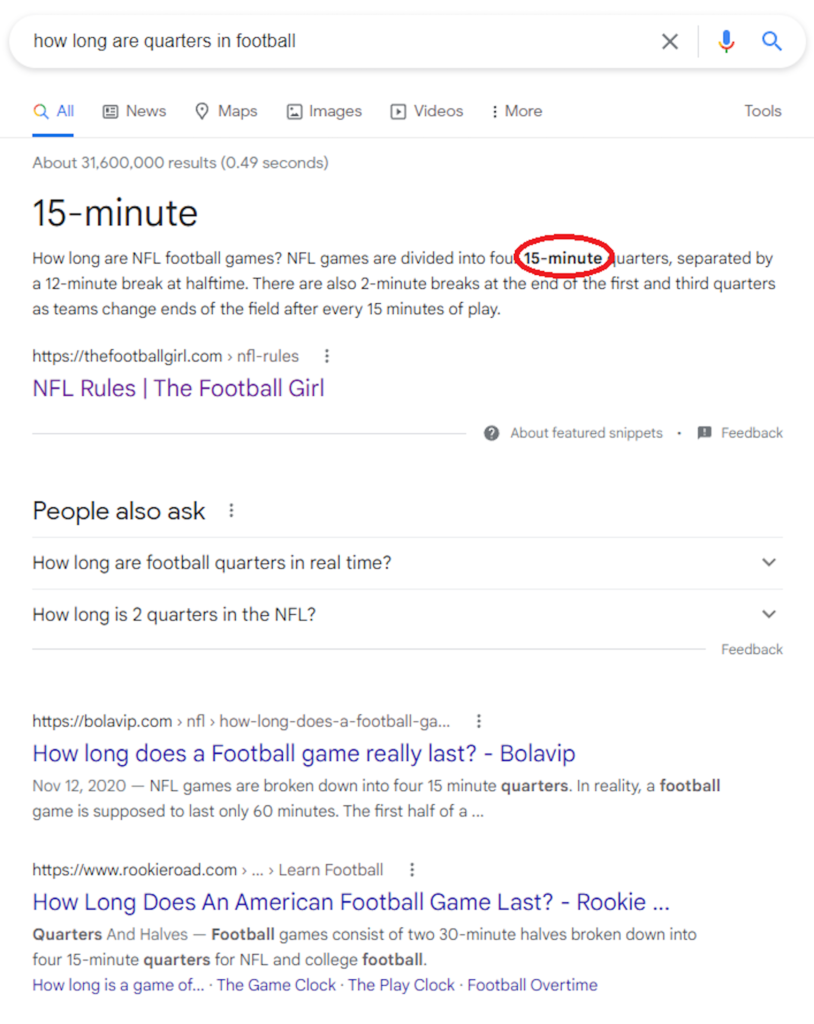
Historically, featured snippets have often been referred to as Google’s answer box or position 0 on a SERP. However, while ranking for a featured snippet used to give you two organic listings on one SERP, a recent Google update deprived websites of that privilege, only giving them the featured snippet on a SERP.
In another recent update, Google even began highlighting text directly on the webpage you click on by adding a special URL parameter to that webpage.
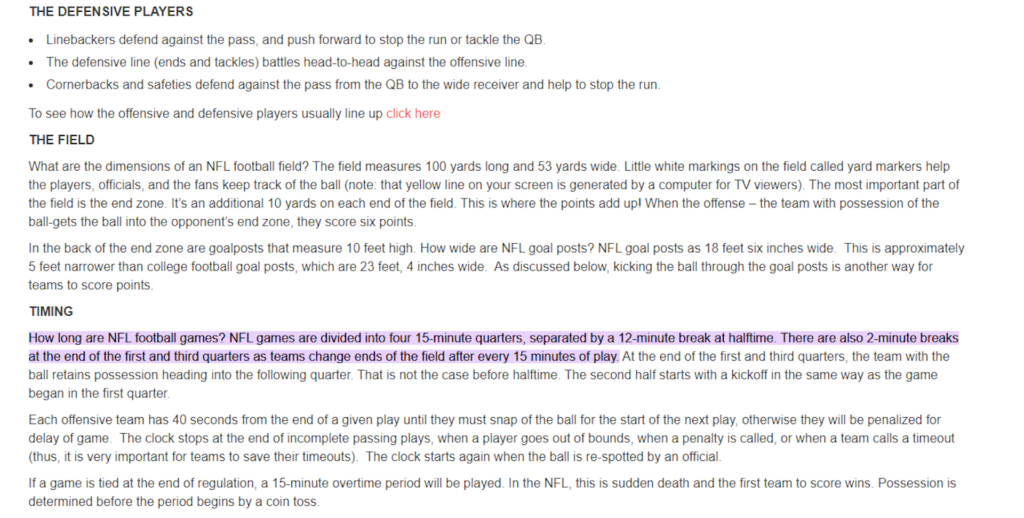
This feature is significant because it will scroll down automatically to where that content is listed on a document. So if you have a long-form piece of content, this featured snippet will help users find the exact section they’re searching for.
In addition, Google may even provide 2 or 3 featured snippets on a SERP for a broad-tail keyword.
However, according to this Stat Analytics whitepaper, only 4% of desktop queries featured more than one featured snippet, and around 12% of mobile searches had two or more featured snippets.
With this in mind, let’s better understand the different types of featured snippets to best optimize our content to rank for each snippet.
4 Types of Featured Snippets
Paragraph
According to the Stat Analytics whitepaper, paragraph featured snippets were the most popular among search results in 2021, with close to 70% of all desktop and mobile featured snippets belonging to paragraph format.
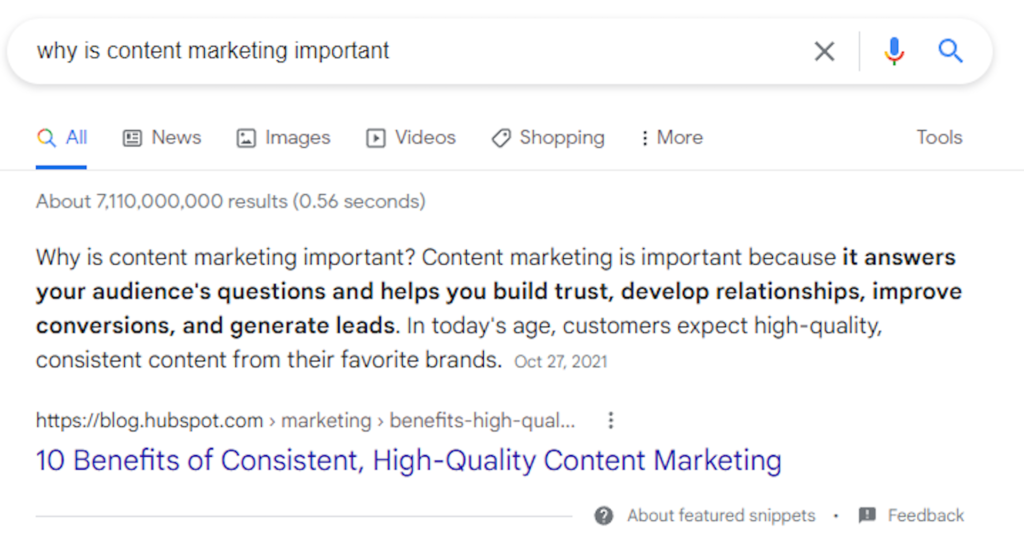
Paragraph featured snippets answer complex questions, especially questions like “why.”
In fact, the same Whitepaper found that “why” keywords were the most popular featured snippet (69% desktop, 67% mobile in 2021) among the five W’s. In addition, “who” and “when” keywords that require more specific answers also typically employ paragraph format.
However, not all featured snippets require question phrases, as many broad tail keywords with simple definitions also come with their own featured snippet and knowledge panel results.
Understanding how to structure content among specific keywords will give you a better chance of ranking for a featured snippet, as we will discuss later.
List
Lists are the second most common featured snippet and provide direct answers to questions that involve multiple steps, DIY instruction, tips, or a list of pros and cons. Accordingly, lists comprised almost 20% of all featured snippets across every device in 2021.
Table
Tables remain relatively rare but are still used in around 5% of all mobile snippets and 3.7% of all desktop featured snippets. Tables are great pieces of content if you are comparing multiple things at once, such as highlighting different prices for an e-commerce or brick-and-mortar store.
Video
Finally, video is by far the rarest featured snippet (2% desktop, 3.6% mobile), but it’s also industry-specific. So, for example, results that are typically dominated by videos, such as DIY home repair and exercise, will display a prominent video result at the top of the page.
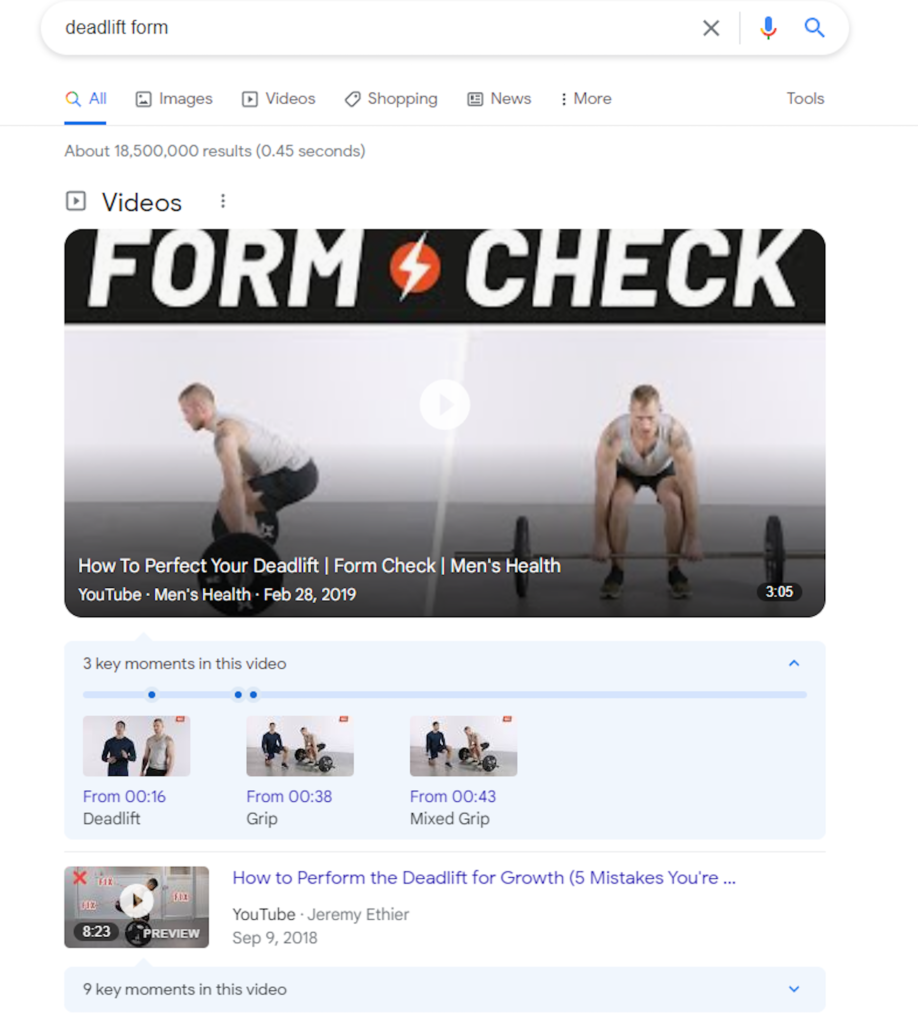
Researching the SERPs to see which content is ranking for specific queries will inform you what mediums users seek to get their answers on and what mediums provide the best chance to reach a featured snippet.
Benefits of Featured Snippets
Satisfies User Intent
Ultimately, featured snippets are employed to satisfy user intent. If Google or any search engine couldn’t provide you with a quick and direct answer to your query, then you wouldn’t use these search engines.
For this reason, optimizing for featured snippets and understanding what content ranks for featured snippets will inform your keyword strategy to optimize around the given intent.
For example, keywords with both commercial and informational intent may come with a featured snippet. Understanding what snippet it is and how it’s optimized will give you the best idea of what answers people are looking for in a given search.

“Content marketing manager” borderlines between informational and commercial intent, yet Google chooses to display informative results at the top. This informs us that most searches are typically looking at an overview of what a content marketing manager does, not to hire one.
Higher Click-Through Rate
Ranking in position 0 for a featured snippet will provide your website with a higher click-through rate. An older study by Ahrefs showed that featured snippets typically resulted in an 8% click-through rate. While updates throughout the years may have impacted this number, it’s safe to say that answering user queries in an answer box may or may not yield a higher click-through rate.
However, many users may not click on a featured snippet, as the answer will often satisfy them. Don’t worry, as this will still provide your website with good brand exposure and entice clicks from other users.
Greater Organic Brand Exposure
Even if users don’t click on your webpage, dominating the top of the search result will impart greater trust in your brand for future searches. The more featured snippets you rank for around a set of topics, the more your website appears authoritative.
Optimize for Voice Search
Finally, featured snippets supply answers to voice searches. With this in mind, it’s essential to optimize for voice search and write content that would sound natural and direct over a voice assistant device like Alexa.
5 Steps to Rank for Featured Snippets
By understanding how featured snippets work, we can employ a keyword and SEO strategy to rank for featured snippets. These strategies should naturally conform to existing best practices and will increase the chance of boosting traffic and clicks to your website.
1. Optimize Existing Content for Featured Snippets
The first step to identifying opportunities for featured snippets is to track existing keywords and separate keywords by queries that contain a featured snippet.
Tools like SEMrush and Ahrefs allow users to get a list of keywords that rank for featured snippets and show you their rank on a given query.
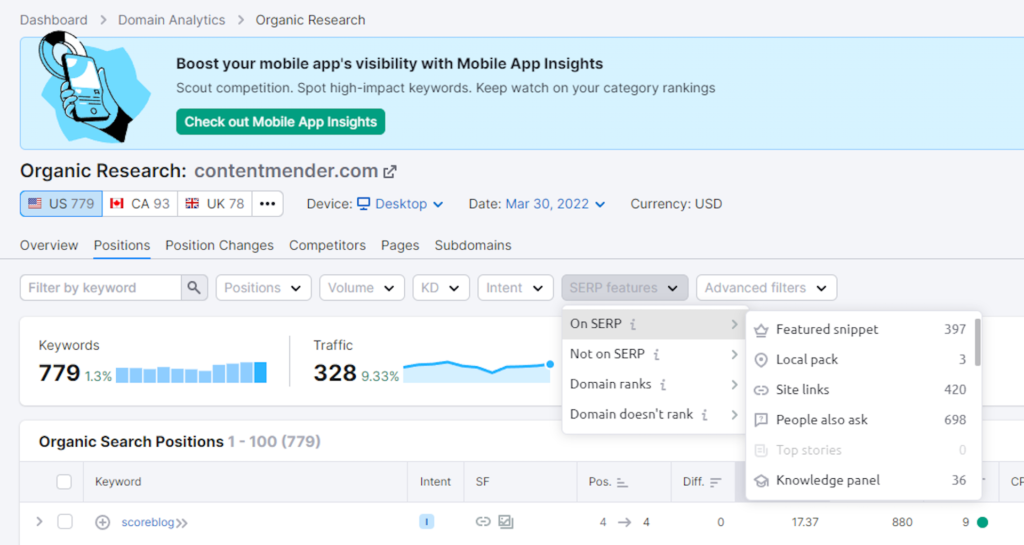
You can then analyze any keywords you rank on the first page that have a chance to rank for a featured snippet.
Next, manually view the SERP or use SEMrush’s SERP Overview tool to see what types of content are ranking for that featured snippet.
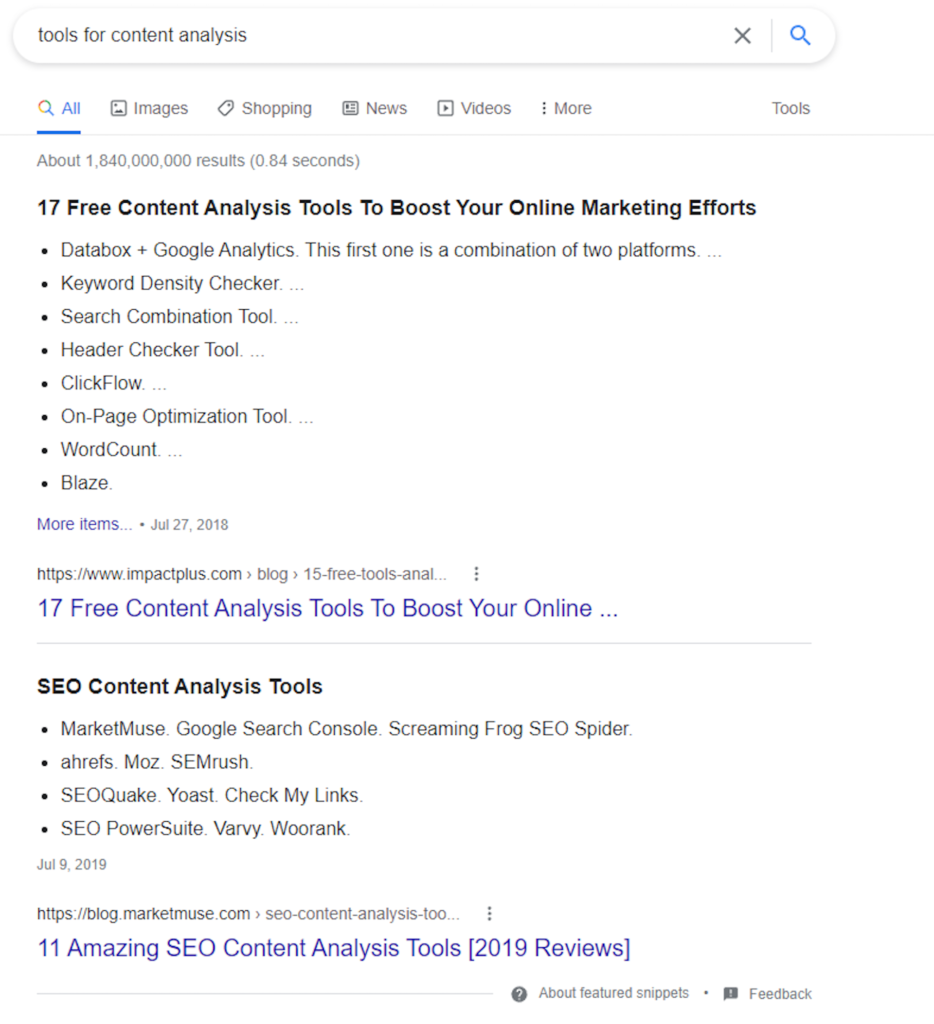
This information informs us that we need to optimize our Content Analysis Tools guide with a list at the top of the page to provide a better chance to outrank our competitors for a featured snippet.
In the same regard, you could check any keywords you rank for on the first page and manually look to see whether or not they have a featured snippet. Then, analyze the snippet and try to model your content to rank for that snippet by providing concise answers that are unique.
2. Identify Keywords with Featured Snippets
Many tools like SEMrush allow you to filter keywords by Featured Snippet when searching for new keyword ideas.
I highly recommend this strategy because these keywords will often come with high informational intent and high search volumes based on past search metrics.
For example, using SEMrush, filter your keyword search using Advanced Filters to click on Featured Snippets and apply the results.

Next, we can filter our results based on which keywords have the most SERP features (i.e. knowledge panel, featured snippet, people also ask).

As you can see, there are plenty of juicy “content marketing” keywords that can be optimized for featured snippets.
These keywords also offer excellent question phrases we can use to create long-form content that dominates the SERPs!
You could also filter your keywords when you export them to a spreadsheet to identify whether or not a particular keyword has a chance to rank for a featured snippet.
3. Ask and Answer Questions
While you may come across numerous keywords with featured snippets in your research, one area where you can effectively filter for potential featured snippets is by adding in question keywords.
For example, SEMrush offers users the ability to filter keyword lists by question phrases around a seed keyword.
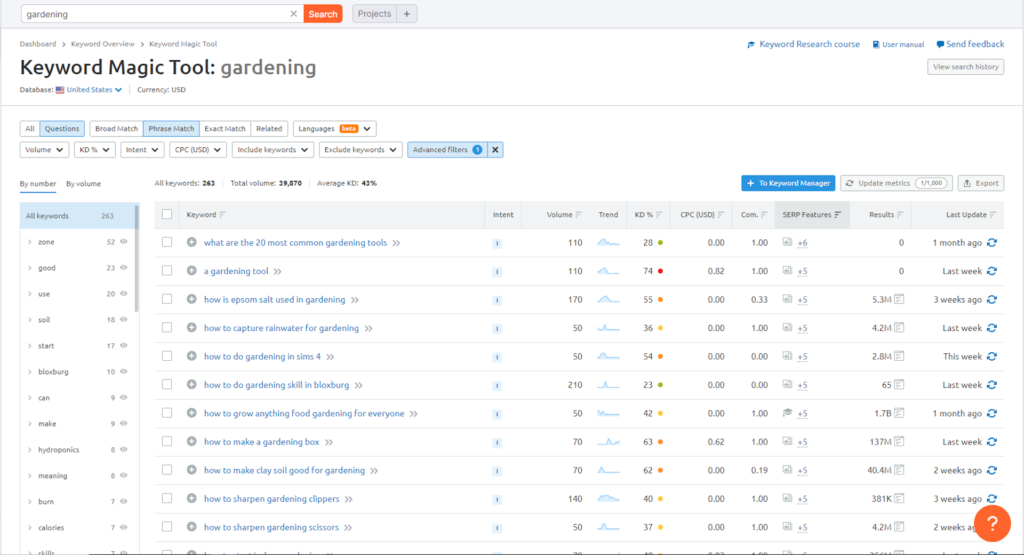
Generally, writing informative content that answers as many user questions as possible is good practice for SEO.
There are several other areas you can look for question phrases, including AnswerthePublic.

You could also look at SERPs in the commonly asked questions box.
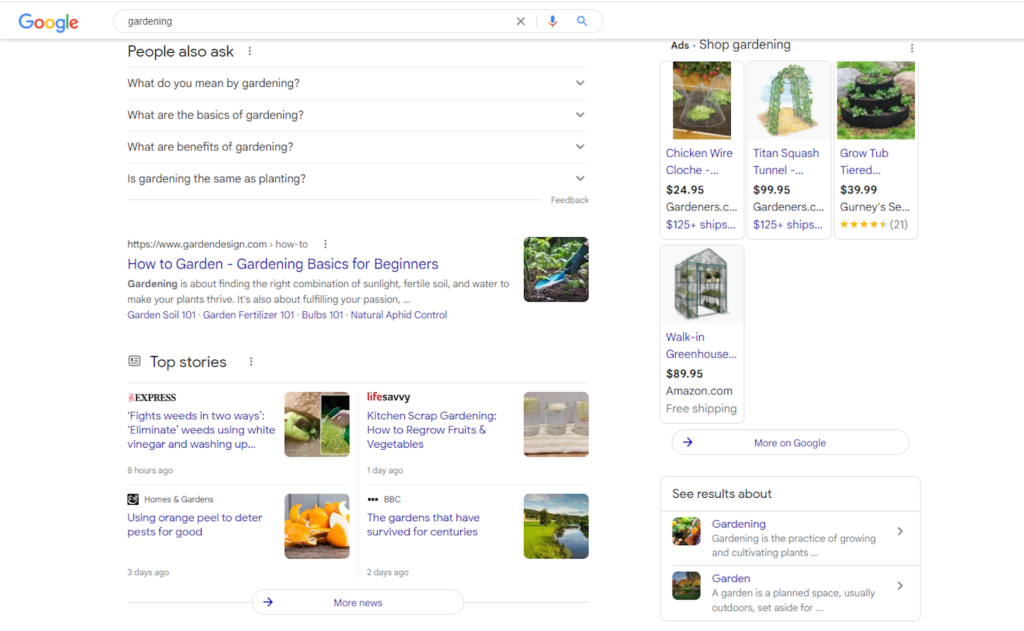

In fact, according to the same Stat Analytics whitepaper, featured snippets and commonly asked boxes are included in the same SERP over 90% of the time on desktop and mobile.
So by answering those questions in the People Also Ask box, you can enrich content to make your webpage stronger and even rank for content in those boxes with featured snippets!
4. Structure Content Appropriately
To rank for featured snippets, it’s important to provide a direct answer. For that reason, when you ask a question, it’s essential to include the seed keyword phrase in the response and offer a direct one to two-sentence answer.
Use the target phrase as an H2 and provide a clear response below. Generally, if you are optimizing for broader seed keywords, this will also help keep content focused and organized.
In addition, it pays to conduct advanced keyword research into what type of featured snippet you want to rank for. If the featured snippet involves a list, create a brief list at the top of your content and add some jump links to make it accessible.
Some featured snippets may involve tables or even videos, so conducting manual research of the SERP and optimizing accordingly is crucial.
5. Maintain Best On-Page SEO Tactics
Finally, it’s crucial to maintain proper SEO best practices.
First, Google generally only uses results from the first page in a SERP. According to whitepaper reference, close to 75% of all featured snippets are drawn from the top 3 positions, with each subsequent position controlling a smaller percentage.
Secondly, featured snippet results also appear on mobile as much as they do on desktop searches. For this reason, optimizing for the following is essential:
- Mobile responsiveness
- Page speed
- Image compression
In some cases, an image may be displayed along with a featured snippet, so including high-quality images is also beneficial.
Finally, you need to keep SEO best practices in mind. For example, optimizing headers, title tags, and metadata with appropriate keywords helps signal to Google your content topic. This information helps them with indexation and ranking.
The more robust and informative your content is, the more likely it will rank for multiple featured snippets.
Optimizing for featured snippets is a highly satisfying strategy that can yield extra clicks and organic brand visibility on your website. In-house SEOs and white label services can take advantage of featured snippets for easy traffic wins and clicks that drive authority to their website.
Furthermore, optimizing for featured snippets can inform us about what questions are most important to users and what strategies our competitors are taking to answer those questions.
Ultimately, following best practices and optimizing content to satisfy user intent and answer as many questions as possible will likely result in some featured snippets we may not even be aware we earned.




